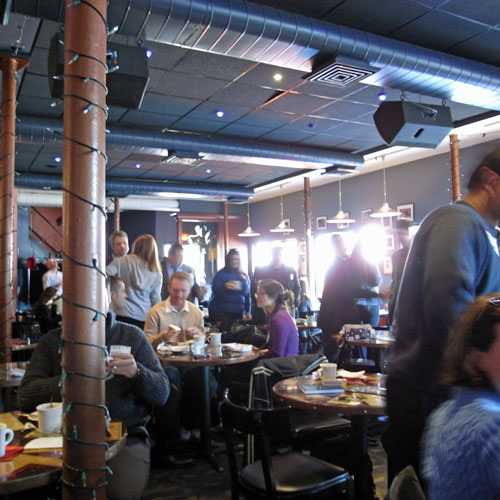Today’s Social Media Breakfast at Ryles in Inman Square was packed. Packed with social media types looking for work and some free pastry, but also packed with meatier than usual discussion of ROI. You can follow much of the live twitter chatter on the hashtag #smb10 even though hashtags are sort of obsolete.
After the schmoozing, Shift’s Robert Collins called the session to order, acknowledged the generosity of sponsor Hubspot, and introduced the topic, social media ROI. Angst about the return on marketing investment is nothing new, and social media marketing has turned out not to be immune to the question, especially in strummy und drangy economic times. Maybe it’s a meme I’m not hip to, but the possibly rhetorical question, “what’s the ROI of putting on your pants?” came up more than once.

The first speaker was Hubspot’s Brian Halligan who opened with the point that people are getting better and better at blocking out traditional (and non-traditional) interruptive marketing. I guess that’s part of why Hubspot sponsors SMB, eh? In any case, Brian showed how Hubspot uses content creation to bring in web traffic and then organizes that traffic by source into funnels leading down to leads and business. A refreshingly pragmatic approach, I think. On the other hand, there is an element of “give away interesting content and they will come” airy optimism here, but he advised us all to ask if we were generating “wonder bread or wheat bread” with traffic from social media sites. I’m a little skeptical of the “intangible ROI” on one of his slides – if its intangible, is it really Return?
Next up, Matt Cutler of Visible Measures (also a Hubspot customer, hmm) talked about his company’s business of measuring online media, sort of like an Arbitron for the YouTube set. My favorite factoid from his presentation was that the #1 predictor of the viewership of a given video is if the artist has just come out with another new video. Apparently, the coattails of a new video, any new video, can carry along older videos by that artist, or – I speculate – other related videos by any artist. He also pointed out that the “how did they do that?” factor contributes to more views as people watch it again and again to figure it out.
Matt also showed some word cloud analyses that I must blog about separately. I love the look of word clouds but have some issues about how people are starting to use them more like tag clouds and thereby overestimate the amount of actual information in them. This vintage limepost tells part of the story.
I also learned from Matt that primetime TV advertising carries a cost in the range of $25 CPM. Interesting to compare that figure to my guesstimated price of $15 CPM for advertising in my twitter stream. Hmm, indeed.
The third speaker was Andy McAfee, an HBS Fellow (with an HBS blog) who was the only one presenting without slides. He began by pondering why you never see ROI figures of less than 100% on those slick documents you get from vendors. Hmm. It turns out, to my surprise, that Andy advocates a more realistic and relaxed view of technology (not just marketing, not just social media) ROI. The says that the chain of cause and effect is so tenuous and attenuated, that it’s an “intellectually bankrupt exercise.” What you can do, Andy says, is you can measure what you can measure on the Investment side – generally how much money and time you spend – and for the Return side, you have to use a different method. You have to tell stories and create scenarios.
McAfee went on to say that conventional “sharp pencil ROI” (the sort Sloanies like me enjoy) is a bit of a lie, and a lie that actually insults people’s intelligence since everybody knows there’s no way those numbers are that accurate. He suggests that we should come to terms with the possibility that costs and benefits could be comprehended in dissimilar terms.
I like it. But will the boss buy it? I hope the social media tweeps in the crowd down’t misread Andy’s talk as permission to throw ROI out the window or to stop measuring things. It’s a call to add some flexibility (agility?) and judgement back into the mix, and I welcome it.

In the Q&A, Sanjay from LuckyCal asked about the relative yield of different media funnels. Hubspot answered that they see less efficiency in the social media funnels, but much higher volume. And Hubspot believes that the volume levels in social media might be made even greater with less effort. Not all web visits are created equal, I guess.
Another Q&A item asked about the valuation of a social media asset, such as a number of facebook friends. The suggestion was that you could value them by estimating what it would cost you to acquire permission to message those people by some other means. But remember folks, your facebook friends are not really assets, you don’t own them, you just have the temporary privilege of communcating with them, revocable at any time.
See you next month at Social Media Breakfast 11, which will be about social media in the nonprofit world…

It was interesting to see in Brian’s presentation the social media was a growing part of their funnel but had a relatively lower conversion rate.
How do people find time to do all of this…virtual socializing, and does it come at the expense of actual socializing – and would that even be considered a negative anyway?
Bonus round: can you spot the duck? http://www.flickr.com/photos/27380453@N08/3025630628/